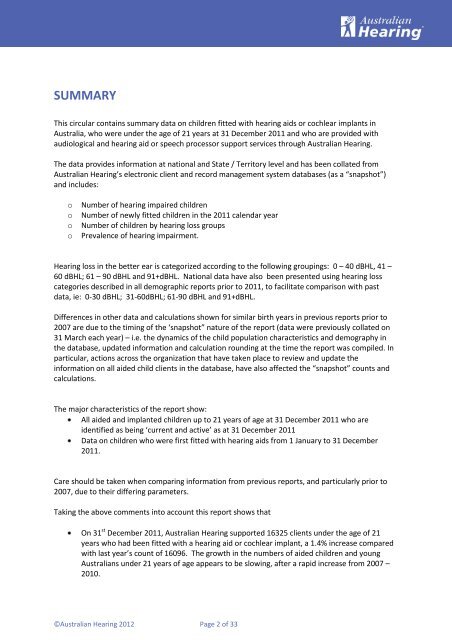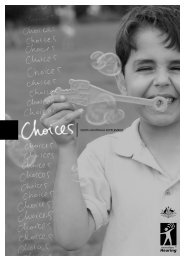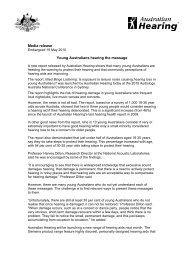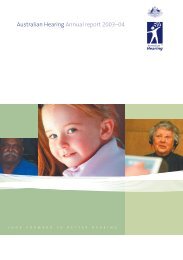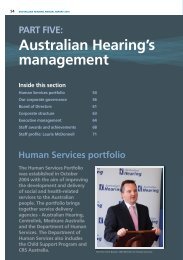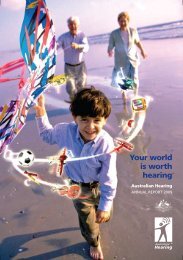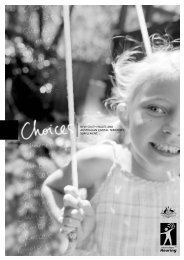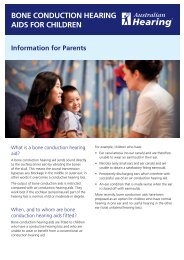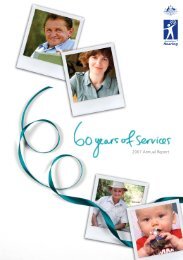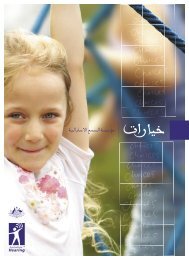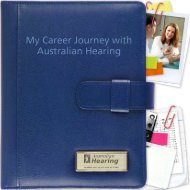Demographics of Persons under the age of 21 years with Hearing Aids
Demographics of Persons under the age of 21 years with Hearing Aids
Demographics of Persons under the age of 21 years with Hearing Aids
Create successful ePaper yourself
Turn your PDF publications into a flip-book with our unique Google optimized e-Paper software.
SUMMARY<br />
This circular contains summary data on children fitted <strong>with</strong> hearing aids or cochlear implants in<br />
Australia, who were <strong>under</strong> <strong>the</strong> <strong>age</strong> <strong>of</strong> <strong>21</strong> <strong>years</strong> at 31 December 2011 and who are provided <strong>with</strong><br />
audiological and hearing aid or speech processor support services through Australian <strong>Hearing</strong>.<br />
The data provides information at national and State / Territory level and has been collated from<br />
Australian <strong>Hearing</strong>’s electronic client and record man<strong>age</strong>ment system databases (as a “snapshot”)<br />
and includes:<br />
o<br />
o<br />
o<br />
o<br />
Number <strong>of</strong> hearing impaired children<br />
Number <strong>of</strong> newly fitted children in <strong>the</strong> 2011 calendar year<br />
Number <strong>of</strong> children by hearing loss groups<br />
Prevalence <strong>of</strong> hearing impairment.<br />
<strong>Hearing</strong> loss in <strong>the</strong> better ear is categorized according to <strong>the</strong> following groupings: 0 – 40 dBHL, 41 –<br />
60 dBHL; 61 – 90 dBHL and 91+dBHL. National data have also been presented using hearing loss<br />
categories described in all demographic reports prior to 2011, to facilitate comparison <strong>with</strong> past<br />
data, ie: 0-30 dBHL; 31-60dBHL; 61-90 dBHL and 91+dBHL.<br />
Differences in o<strong>the</strong>r data and calculations shown for similar birth <strong>years</strong> in previous reports prior to<br />
2007 are due to <strong>the</strong> timing <strong>of</strong> <strong>the</strong> ‘snapshot” nature <strong>of</strong> <strong>the</strong> report (data were previously collated on<br />
31 March each year) – i.e. <strong>the</strong> dynamics <strong>of</strong> <strong>the</strong> child population characteristics and demography in<br />
<strong>the</strong> database, updated information and calculation rounding at <strong>the</strong> time <strong>the</strong> report was compiled. In<br />
particular, actions across <strong>the</strong> organization that have taken place to review and update <strong>the</strong><br />
information on all aided child clients in <strong>the</strong> database, have also affected <strong>the</strong> “snapshot” counts and<br />
calculations.<br />
The major characteristics <strong>of</strong> <strong>the</strong> report show:<br />
All aided and implanted children up to <strong>21</strong> <strong>years</strong> <strong>of</strong> <strong>age</strong> at 31 December 2011 who are<br />
identified as being ‘current and active’ as at 31 December 2011<br />
Data on children who were first fitted <strong>with</strong> hearing aids from 1 January to 31 December<br />
2011.<br />
Care should be taken when comparing information from previous reports, and particularly prior to<br />
2007, due to <strong>the</strong>ir differing parameters.<br />
Taking <strong>the</strong> above comments into account this report shows that<br />
On 31 st December 2011, Australian <strong>Hearing</strong> supported 16325 clients <strong>under</strong> <strong>the</strong> <strong>age</strong> <strong>of</strong> <strong>21</strong><br />
<strong>years</strong> who had been fitted <strong>with</strong> a hearing aid or cochlear implant, a 1.4% increase compared<br />
<strong>with</strong> last year’s count <strong>of</strong> 16096. The growth in <strong>the</strong> numbers <strong>of</strong> aided children and young<br />
Australians <strong>under</strong> <strong>21</strong> <strong>years</strong> <strong>of</strong> <strong>age</strong> appears to be slowing, after a rapid increase from 2007 –<br />
2010.<br />
©Australian <strong>Hearing</strong> 2012 P<strong>age</strong> 2 <strong>of</strong> 33


